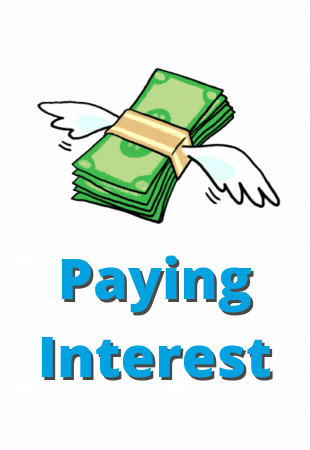What Are Interest Rates? (When I'm Paying Them on Loans)
You can earn interest or pay it. This article is about loans and credit cards and the interest you pay to utilize these. Check out Part 1 of the series here to learn about earning interest on your savings and investments: What Are Interest Rates? (When I'm Earning Them on Savings)
Interest plays a role in almost all aspects of personal finance, including savings, investing, credit and loans. Interest is money that's added to your starting balance. It’s typically expressed as a percentage. That percentage is known as your interest rate.
If you're all too familiar with interest rates and a growing mountain of debt, we invite you to say cheers to a debt-free future with our free DIY debt relief bundle. Worksheets, tools, and guidance are provided to help you get out of debt and stay that way, if that's what you want for your financial future.
What Are Interest Rates?

You pay interest when you borrow money through a loan, credit card or other line of credit.
It’s important to consider interest when choosing a financial product because the rate that you pay can significantly impact your overall financial picture.
For example, when you buy a house, you will pay interest at a specific rate over the life of your home loan. How much you pay overall will vary by thousands (!) of dollars based on the interest rate you are offered at the start.
On a $200,000, 30-year home loan paying 4% interest, total interest paid would be $144,000.
For the same loan but with 6% interest? You'll pay $232,000 or $88,000 more - just for interest. 😱
Interest Rate vs. APR
Although some people use these two terms interchangeably, there is a difference!
Similar to the deposit side with APY, a loan’s annual percentage rate (APR) provides a full view of the cost of a loan because it includes the fees you pay to arrange the loan as well as the annual interest rate. The annual percentage rate is the percentage you'll pay of the whole loan amount, on a yearly basis. 5% APR for a loan of $1,000 is about $50 per year. That $50 per year is the cost you're paying for that loan.
Interest rates, and thus APRs, vary widely depending on what’s happening in the economy as a whole. What doesn’t change, however, is that you want the lowest APR you can find.
Lower APR = Lower Overall Cost to You
Did you know all banks and credit unions are required to provide you with the APR, not just the rate. Why? Because it ensures a realistic view of the loan and its overall costs.
If Bank 1 says "Get a $10,000 personal loan at only 5% interest rate!"
While Bank 2 says "Our personal loans are available at 6.12% APR!"
Bank 1's deal sounds better, right? But in this case, Bank 1 is charging a yearly maintenance fee and an underwriting fee for the loan. When all that's factored in, Bank 1's APR is actually 7.25%. Because regulations force institutions to provide APR, it makes it easier for you to compare Bank 1 and 2 and make an informed decision factoring in all costs of a loan. And because Bank 2's APR is lower than Bank 1's - Bank 2 is going to save you more money on that loan.
Of course, rates offered are impacted by your credit history and other factors. Taking a quick look at your free credit score as well as a credit score chart are always a good idea before booking a loan.
What Are Interest Rates: Credit Cards and the Dark Side
Interest plays a role in the use of credit (specifically credit cards) in a big way. There are two types of credit card users in this world:
Perma-Payers: People who pay their credit card bills in full and on time, every month. They likely will use a credit card for points or rewards but always have the cash on hand for the items they buy. They can immediately pay their card off at any time. Having a credit card usually costs close to nothing for this group (as long as the card doesn't come with a yearly fee).
Ready-Revolvers: People who use credit cards but only pay part of the outstanding balance on their credit card each month. They have what's referred to as a 'revolving balance' because it usually is not paid off completely. Maybe they're making the 'credit card minimum payment' as noted on the statement, or a different amount each month but either way these folks will owe interest on the unpaid balance as well as any new purchases.
.png?width=251&name=400%20x%20500%20earn%20interest%20(1).png)
Don't know which one you are?
Ask yourself this one question:
"Could I pay off my full credit card balance(s) in full with the money currently in my checking account right now?"
If yes, you may be a perma-payer.
If no, you may be a ready-revolver.
Everyone's different and there usually isn't one right answer for everyone! Nonetheless, it's worth understanding the details of credit cards and being mindful of how balances can grow and grow.
How Are Credit Card Interest Rates Calculated?
Most commonly, credit card interest rates are compounded daily on the outstanding balance. Put simply, this means that at the end of each day, interest is calculated and added to the total. The next day you're paying interest on that new total, which includes the previous day's interest. So every day, your balance is growing as interest is added.
This is the flip side of compounding—instead of helping you grow your account value, it increases the amount you’ll need to repay to the credit card company. This is why paying only the ‘minimum payment’ on your credit card can put you at risk for years of payoff time. We find this calculator really helpful for understanding the impact of making more than the credit card minimum payment for those who resonate with ready-revolvers.
P.S. - Credit cards aren't the only product with high interest rates/APRs, car title loans and payday loans are risky loans that frequently lead to mountains of debt. Still somewhat legal in Arizona, these predatory loans will hurt your pocketbook even more than a credit card will. Seriously, like 10x more.
Read more about it here: Why Credit Unions Say Beware of Car Title Loans and Payday Loans.
What Are Interest Rates Doing To My Other Loan Types? (Not Credit Cards)
Similarly, when you take out a traditional loan such as a car loan or other term loan, you have to pay back 1) the amount you borrowed (principal) and 2) the interest that accrues on that amount.
Shopping around for a loan involves figuring out what your total cost will be. This includes both of the above and also factors in the term or length of the loan, as well as any additional fees.
The term of a loan is key to keeping your total cost as low as possible, simply because a shorter term means that you’ll pay interest for fewer years. Here's an example: If you borrow $10,000 and are paying 10% APR:
3-year Term: $322.68 per month and $1,590 total for interest
5-year Term: $212.48 per month and $2,700 total for interest
Is that lower monthly payment worth 2 more years and $1,100 more of your money going to interest? It's worth thinking about if you can afford the higher monthly cost in your budget plan.
Conclusion: What Are Interest Rates?
The short answer is that interest rates are simply the cost of borrowing money. Most everyone will have to do it at some point, whether it's for a house, home improvements, a car, an education (not many of us have enough in a college savings account!) or otherwise. Understanding 'what are interest rates' and how to compare APRs will save you money and set your mind at ease as you borrow.
1 This article is intended to be a general resource only and is not intended to be nor does it constitute legal advice. Any recommendations are based on opinion only. Rates, terms and conditions are subject to change and may vary based on creditworthiness, qualifications, and collateral conditions. All loans subject to approval. Membership is required.



